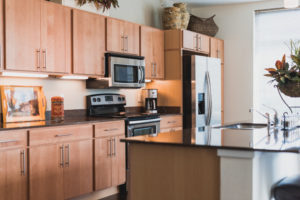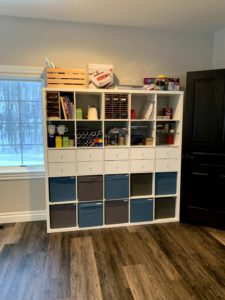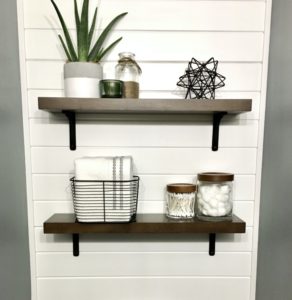Living large in small spaces
Clever apartment styling and décor
They say good things come in small packages, but when the “thing” is your living space, it can be a challenge to appreciate and utilize.
Yet almost 39 million people in the United States currently live in apartments. So how do you maximize space and make apartment living feel cozy, warm and unique?
First, ask questions and gain clarity about what’s allowed and what should be left alone in your space. Rental agreement guidelines necessitate tenants to get creative.
“I recommend always reading your lease or checking with your landlord to fully understand the specific regulations in your apartment community,” Stephanie Wicherski, Chief Operating Officer of RiverHeath in Appleton, says. “For example, to assist with the maximum return of their security deposit at move out, tenants should avoid large holes in the walls, painting walls and permanent fixtures.”
 “(Apartments) can be kind of a neutral base. This is a great opportunity if you want to add interest or you want to add color or contrast, you can bring it out in your furnishings and your décor,” Lori Jansen, Designer and Owner of Design House Interiors, LLC, adds. “It’s a great way to still get your style and look.”
“(Apartments) can be kind of a neutral base. This is a great opportunity if you want to add interest or you want to add color or contrast, you can bring it out in your furnishings and your décor,” Lori Jansen, Designer and Owner of Design House Interiors, LLC, adds. “It’s a great way to still get your style and look.”
1. Less is more. Be intentional.
To say “less is more” may seem like obvious advice in the design of a small space, but the adage couldn’t ring more true. Many think it’s necessary to use it if you have it, but paring down in terms of both furniture and decorations can work wonders in making a room look and feel larger.
“I think one of the things that is important to remember when decorating a smaller space is to leave white space in your home rather than overfilling it,” Sara Campana, Professional Organizer and Founder of 1 Touch Organizing in Appleton, explains. “Our minds need white space to rest and relax. Often people will hang on to too many items from their past, which leads to clutter that can cause us to feel stressed and anxious.”
Keeping design clean and simple by removing clutter is key.
“Learning to let go of things that no longer serve us… is beneficial to both our physical space and our mental and emotional well-being. Professional organizers like to define clutter as ‘delayed decisions,’” Campana says. “When your space is filled with piles of delayed decisions it makes it difficult to live in the now and find peace in our spaces.”
She further explains the process of paring down can be difficult, but suggests considering how the removal of certain belongings will truly affect your daily life. Often, she says, it’s simply a minor inconvenience.
2. Create multifunctional rooms + utilize dual purpose items.
For the items that do stick around, multifunctional pieces provide an intentional and simple way to hide clutter and add to the aesthetics of the room.
“We use baskets with lids a lot,” Leslie Mayer, Senior Designer and Owner of Bellwether Interior Design in Neenah, says. “If you have kids or pets or anything like that, put their stuff in a basket and have a lid on it. It feels cleaned up and it also has the boho vibe that’s in right now. It’s creating interest with content but also privacy so people aren’t seeing everything.”
 “Maximize your space (by owning) pieces of furniture that do more than one job,” Campana adds. “A colorful ottoman that can serve as a storage piece, a beautifully made bed with drawers underneath it for off-season clothing or a bookshelf that not only displays your favorite reads, but also holds decorative bins of office supplies or files provide not only great function, but also beautiful décor.”
“Maximize your space (by owning) pieces of furniture that do more than one job,” Campana adds. “A colorful ottoman that can serve as a storage piece, a beautifully made bed with drawers underneath it for off-season clothing or a bookshelf that not only displays your favorite reads, but also holds decorative bins of office supplies or files provide not only great function, but also beautiful décor.”
Not only do interior designers recommend design elements to be multifunctional, but suggest rooms themselves, double their function to maximize space and create clear boundaries.
“A lot of times we will make a room dual purpose just to maximize the function of it,” Jansen says. “Maybe a guest bedroom also has a desk in it so it can be a guest bedroom and a home office. That way you’re getting that dual purpose, that multifunctional space that works both ways.”
“Quite a few of our tenants are working from home now, so desk space is key,” Wicherski adds. “Make a dedicated work area for yourself to be successful. Use hooks, floating shelves with stylish stacking boxes for storage and over-the-door organizers are great to stay organized and on task.”
3. Consider weight + visual scale.
Mayer says an easy way to understand “to scale” is envisioning an entryway with tall, vaulted ceilings and a sole small light in the corner. The space can easily handle more oversized furnishings.
“When it comes to small spaces, if it feels like it’s an overstuffed piece or it’s extremely deep, it’s ultimately going to feel like it’s taking up the whole space,” she says. “It feels like the room is tighter.”
It’s not the true weight of the piece, but its visual scale that dictates if something fits in a space. Examples of light, airy styles of furniture—perfect for apartments—include rattan, glass, metal and track arms versus rolled arms, while those that carry a heavier visual weight are upholstered pieces, leather and solid wood.
“Form follows function, but you do really need to focus on function for those smaller spaces,” Mayer explains. “If you put in an accent chair, maybe it can’t be fully upholstered, the arms need to be open so there’s the illusion that things feel lighter.”
Mixing pieces and textures also allows for functionality. For example, a large bed that fills up a room can be matched with smaller scale nightstands. Adding intentional accessories help and have a large impact on the overall harmony of a room as well.
“To give the illusion of a larger space or to brighten up your apartment home, a well-placed floor mirror will reflect light and make the apartment feel larger,” Wicherski adds.
4. Get things off the ground.
Apartments tend to have smaller rooms and functional furniture is necessary, so it leaves a loss of space for storage.
“One of the best ways to maximize your space in a small setting is to go vertical,” Campana says. “Utilize pieces of furniture that allow you to store items all the way up to the ceiling, hang decorative shelves on the walls to show off your treasures and take advantage of often overlooked areas to store items like the backs of doors.

“Utilizing wall hooks or pegboard to organize and store kitchen utensils, coats and bags, cleaning supplies, jewelry or clothing is a great way to keep items off the floor or other flat surfaces where they tend to get piled.”
Closets are a great area to maximize storage space and can often be temporarily updated for individual needs.
“You might not be able to do something permanent but I have recommended adding a little cabinet of drawers, adding some shelving things that you can easily add but take out of the space so it’s not permanent,” Jansen says. “There might be just one hanging pole in a closet but a lot of times you can do double to double storage.”
“Hang a bookshelf, use floating shelves,” Mayer agrees. “You don’t want to bring the weight down. Switch out your stuff seasonally. Put your sweaters in your tote and then bring out your tank tops.”
5. Play with texture + color.
Monochromatic color schemes are back in style in a major way, which lends itself to adding pops of brightness and texture in fun accessories. It’s well-known that dark colors have no place in small rooms. And it’s true—to an extent.
“There are rules, and then you can break the rules,” Jansen says. “The general rule of thumb is that neutral colors, lighter colors, are going to make a space feel bigger. So you don’t want too many dark things in a space.
But maybe if you do want a darker sofa we layer it with lighter pillows, a lighter throw. As long as there’s a good balance to the selections and the colors, I think there’s a great way to still add some contrast, add some color and still add interest without it being too plain or neutral.”
 “Design is really subjective. Each person’s style is what it is,” Mayer adds. “You can embrace that in any area because your space is really a reflection of you. And I think that’s important to keep… If you’re more of a colorful person, a rug is a great way to mix in color and is easier to change out too.”
“Design is really subjective. Each person’s style is what it is,” Mayer adds. “You can embrace that in any area because your space is really a reflection of you. And I think that’s important to keep… If you’re more of a colorful person, a rug is a great way to mix in color and is easier to change out too.”
The impact of color isn’t reserved for accessories or walls. It can also be felt in lighting temperatures. Apartment lighting is typically reserved to overhead lighting, which often has the opposite effect of warm ambiance. LED lights, while previously solely cool light, now offer warmer options. The lower the Kelvin, the warmer the light.
“One of my favorite things in design is lighting because it plays such a key role. If you can have that secondary lighting it creates a softness,” Mayer says. “It’s a way to make it your own, to put your own personality in things.”
“I saw it on Pinterest”
While social media offers fun, inventive ideas and how-tos, our experts urge us to look deeper than the curated photos to think about execution and the end result before deciding on a new project.
“I have a love/hate relationship,” Jansen chuckles. “You go on Instagram and Pinterest and there’s this picture that’s filtered and edited perfectly where someone is saying ‘Look what I did.’ But it’s from afar and with a filter. It looks great but up close it’s different.”
Peel and stick wallpaper, a popular component in apartments, while in theory a great temporary solution, can be misleading in terms of outcome expectations.
“It can be deceiving. There are some peel and stick wallpaper options but the final outcome may not have the best finished look,” Jansen explains. “Sometimes when it boils down to it, it’s not worth it.”










Leave a Comment